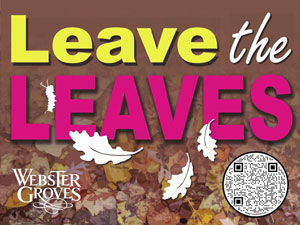
By Jean Ponzi
As your pollinator garden fades toward winter sleep, what do all the lovely insects you have kindly nourished need? They need you to do next to nothing.
Invertebrates rely on fallen leaves for insulating cover when days turn cold. The ideal shelter is accumulating now, right in their summer places.
Most butterfly and moth species overwinter in the landscape, as an egg, caterpillar, chrysalis, or adult. Bumblebees, spiders, snails, worms, beetles, millipedes, mites, and more also rely on leaf litter for protection. These animals, in turn, are food for chipmunks, turtles, birds, and amphibians.
Where insects emerge in spring, they will pollinate promptly with each flowery meal. Awakening bugs and gardens thrive. Your fall-chore free time can naturally re-weave the Web of Life, underfoot without lifting a finger. Leaving the leaves? What’s not to like?
Okay, so you wrestle with your training (and guilt) to keep a tidy lawn. This fall the City of Webster Groves asks residents to evolve that ideal, encouraged by the community’s Green Space Commission.
Webster’s campaign to Leave the Leaves – first in our region – joins a human movement toward ecological best practice.
“Raking or mowing fallen leaves cuts the overall biodiversity benefits of your pollinator plantings,” says Green Space Commissioner Carrie Coyne, “but you can modify leaf-moving to suit your situation. For example, if leaves in your front yard would drift into a storm drain, move those off the turf, onto planting beds or in rings around your trees. Pile leaves as a donut, pulled away from the tree trunk out to the drip line, the branching outer perimeter.”
Webster offers colorful signs, sold at the Recreation Center, to show that your leaf-largesse is purposeful, not lazy.
“Be mindful of your neighbors,” says Coyne. “If they love clean, crisp edges, move your leaves away from your property borders. Eco-logic is considerate of others: insects, plants, and people. Have a conversation about what you are choosing to do, and why.”
Big benefits also accrue to our trees and soil, when Nature’s rich organic “waste” is allowed to transform in place instead of being raked and bagged up and hauled away.
Webster Green Space Commissioner Corin Purcell says, “Forests are self-mulching!
Leaves provide free, healthy nutrients that trees need. When we follow forest expertise and let fallen leaves decay, they add organic matter back into the soil, so you don’t need to fertilize. And micro-organisms, the life in soil, need food and nutrients all the time.
Everybody’s nourished, everybody thrives – and you pay less and do less work.”
Based on their yard experience, Coyne and Purcell concur that a winter coat of leaves will help, not kill, the grass. “Some cover is beneficial, like mulch in your garden,” says Coyne. “Decaying leaves help turf roots and soil retain water, as much as 20-40%.” Purcell reports that his lawn rebounded richer than the growing season before, after winter months covered 4-6” deep with leaves.
Both emphatically state why leaving leaves is sustainable: “Mowing and blowing use fossil fuels and make neighborhoods noisy,” says Coyne. Purcell adds, “We can improve our quality of life, along with ecological health, by letting Nature manage the season-ending work of fall.”
Enjoy some autumn rambles in the hours you reclaim from raking and mowing – and let Nature nourish you!
Jean Ponzi shares Green ideas in conversations through her podcast Earthworms, a 35-year service from KDHX St. Louis Community Media. Leave the Leaves in Webster Groves expands success with No Mow April, earlier this year. Intel and resources from both campaigns are available at www.webstergrovesmo.gov to residents and other communities.


